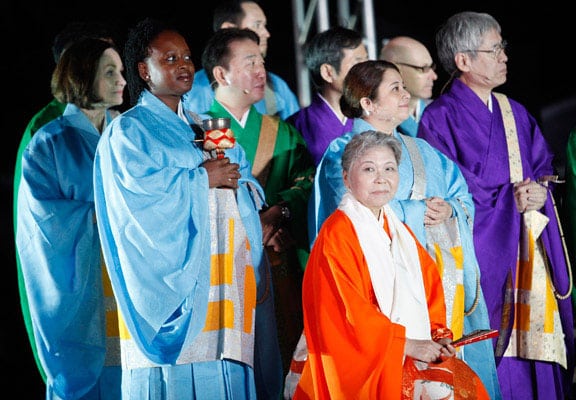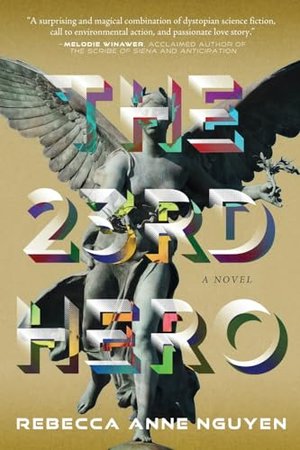

Credit: Thos Robinson, Getty Images.
NEW YORK (WOMENSENEWS)-Darkness and autumn's first chill enveloped the crowd of 1,000 or so gathered to honor female peacemakers in Manhattan's Central Park. Musicians pounded on kettle drums and hit gongs as translucent lanterns floated by, their glows reflected in the small lake created for the Sept. 22 Shinnyo Lantern Floating for Peace ceremony.
On a very different stage blocks away, world leaders were gathering for the next day's opening of the United Nation's General Assembly that would run until Sept. 25, there to wrestle with the resolution regarding Syria's use of chemical weapons. Would they be able to bring even a temporary ceasefire to Syria? And what about the armed massacre the day before in Kenya? And the assassinations of female leaders in Afghanistan? Would those issues be addressed? Could the U.N. bring peace anywhere?
I assumed that the event would be as pleasant as the idea of peace and, given current events and recent history, no more than that. Instead, something I believe is truly remarkable occurred, on the world stage and in my soul.
Center stage was Shinso Ito, clothed in a bright orange robe with contrasting yellow stripes on the voluminous sleeves. She is one of the highest ranking female Buddhist leaders and was flanked on either side by an entourage of women and men, dressed in brilliant green, blue and purple.
Given my role as a professional observer, I assessed the opening with reserve. Good setting, I thought, but too bad a helicopter is flying over while the siren wailed on an ambulance passing nearby. I wondered how much the huge video screen cost to rent. Strong visuals, I thought, but the camera operator needed to zoom in for more close-ups of the stage. The tops of the surrounding trees, still green, danced in the wind. Very peaceful.
One lantern was stashed underneath the chairs of the press section and I picked it up with the expectation of taking it home as a souvenir of a lovely evening. I had no intention of joining the other attendees who had written a peace message on their lanterns and sent them off to float away in the lake. I am a journalist after all; I don't join in.
‘All Violence is Connected'
At least I didn't until Anne Marie Goetz, chief advisor of peace and security at UN Women, was given her moment in the spotlight.
“Peace in the world must be grounded on peace in our homes,” she said. “We cannot end armed conflict without also ending the violence against women and children at home. All violence is connected.”
I was disarmed. During the last decade I have attended numerous events and conferences focused on violence against women. This was the first time I had heard a high-ranking public official connect domestic violence and war. I thought I was the only one who thought that way.
Throughout my journalism career, I have covered violence from domestic homicides to the torture of political prisoners. I often speculated privately about the connection to the brutality soldiers experienced in the battlefield and the barracks and the almost scripted assaults on women across the globe. The reasons given, the curses used, the sheer irrationality of physically attacking a loved one. And were people who've been tortured compelled to become the torturer, doomed to re-enact what they themselves had endured?
Goetz was followed by Chloe Breyer, executive director of the Interfaith Center of New York. She dedicated her lantern to “all those women of faith who are survivors of gender violence, whether it takes place in conflict zones like Syria or behind apartment doors in our own city.”
There it was again. The connection between the violence women and girls endure at home and what they confront in their homelands.
She went on to say that women of faith who stand up for themselves and for their children were “courageous.” They are “showing the world that they are not only victims but can also be powerful agents of peace.”
I sat up. She just called us courageous, agents of peace; all the women who managed to leave violence behind: the refugees in Syria and my former neighbor and me.
Looking Back
I married Jim Jensen at age 18 and had a baby before my 19th birthday. He had thrown me down stairs, pushed me out of moving cars, threatened me with a knife, exploding often and unpredictably. During moments of calm, he had also told me that his father, a career Army man, had whipped him so badly once when Jim was in elementary school that the military threatened to court martial him, a threat that went nowhere. Jim has been dead now for a decade and I never rued his passing.
The fear I felt when I left him just before I turned 24 came rushing back. Back then, I had no job, no college degree and two daughters to raise. It was in the 1970s; there were no shelters, no hotlines, no community support and the phrase domestic violence had not entered yet into common usage. Four years later, as a graduate of Ohio State and a member in good standing of the campus's Single Mother Support Group, I had come to understand through the group that many women were battered and in my women's studies classes that violence against women was global.
I spent the six months before I left for Columbia University's Graduate School of Journalism organizing the first battered women's shelter in Columbus, Ohio. (There are now six organizations serving battered women in my hometown.) At Columbia, my thesis topic was the failure of the New York City police to arrest men accused of assaulting their partners and their refusal to protect their victims.
Now I had witnessed the flowing upward of the domestic violence movement and its connection to organized violence at the highest international levels.
Out of nowhere, the love I once had for Jim when I was 18 came flooding back.
I held the lantern in my hands, stooped down and placed it in the lake. I gave it a shove and off it floated, as I said to myself for the first time ever: Jim Jensen, may you rest in peace.
Rita Henley Jensen is founder and editor in chief of Women's eNews.
Would you like to Comment but not sure how? Visit our help page at https://ihtbd.com/help-making-comments-womens-enews-stories.
Would you like to Send Along a Link of This Story? https://ihtbd.com/story/our-daily-lives/130926/speakers-find-peace-end-domestic-violence

